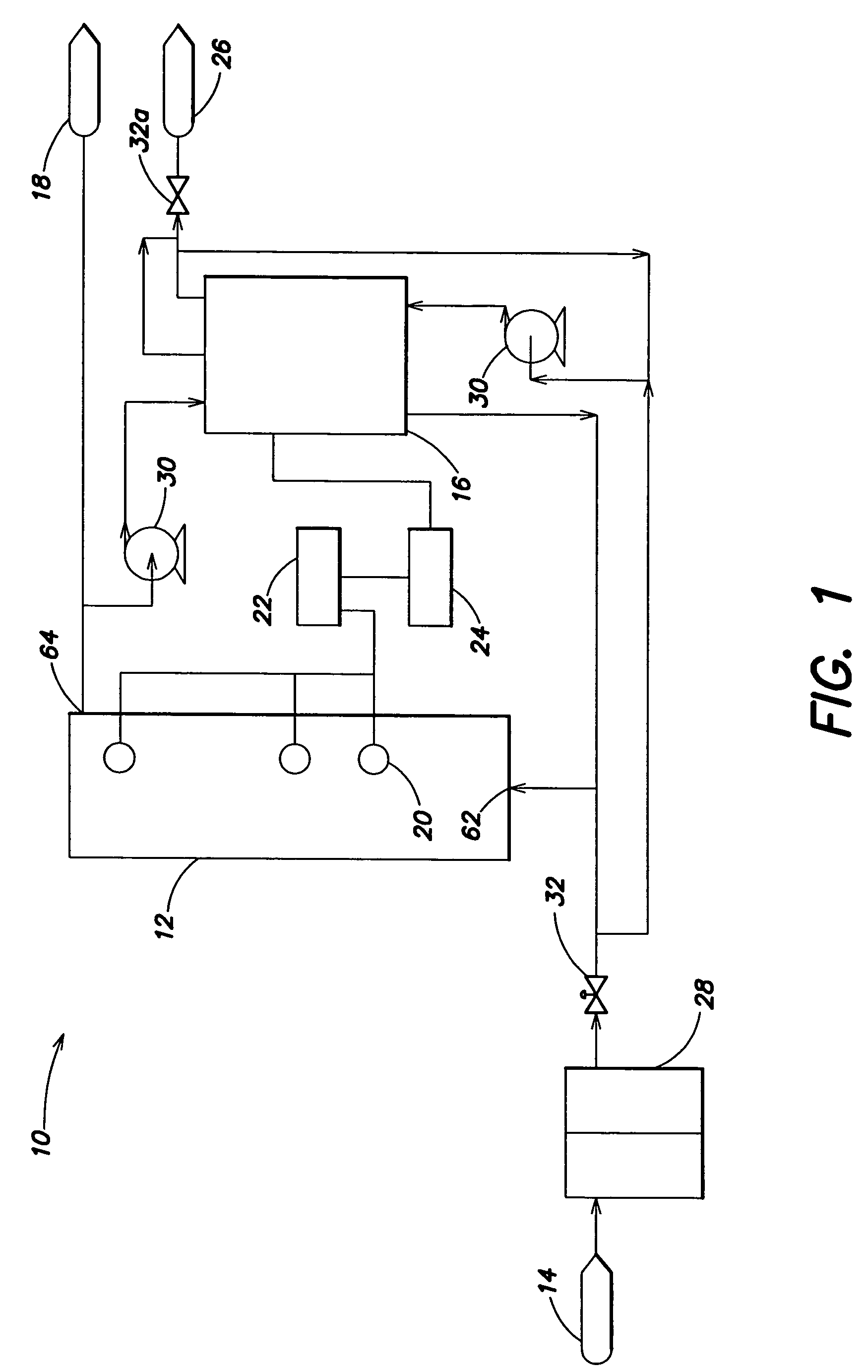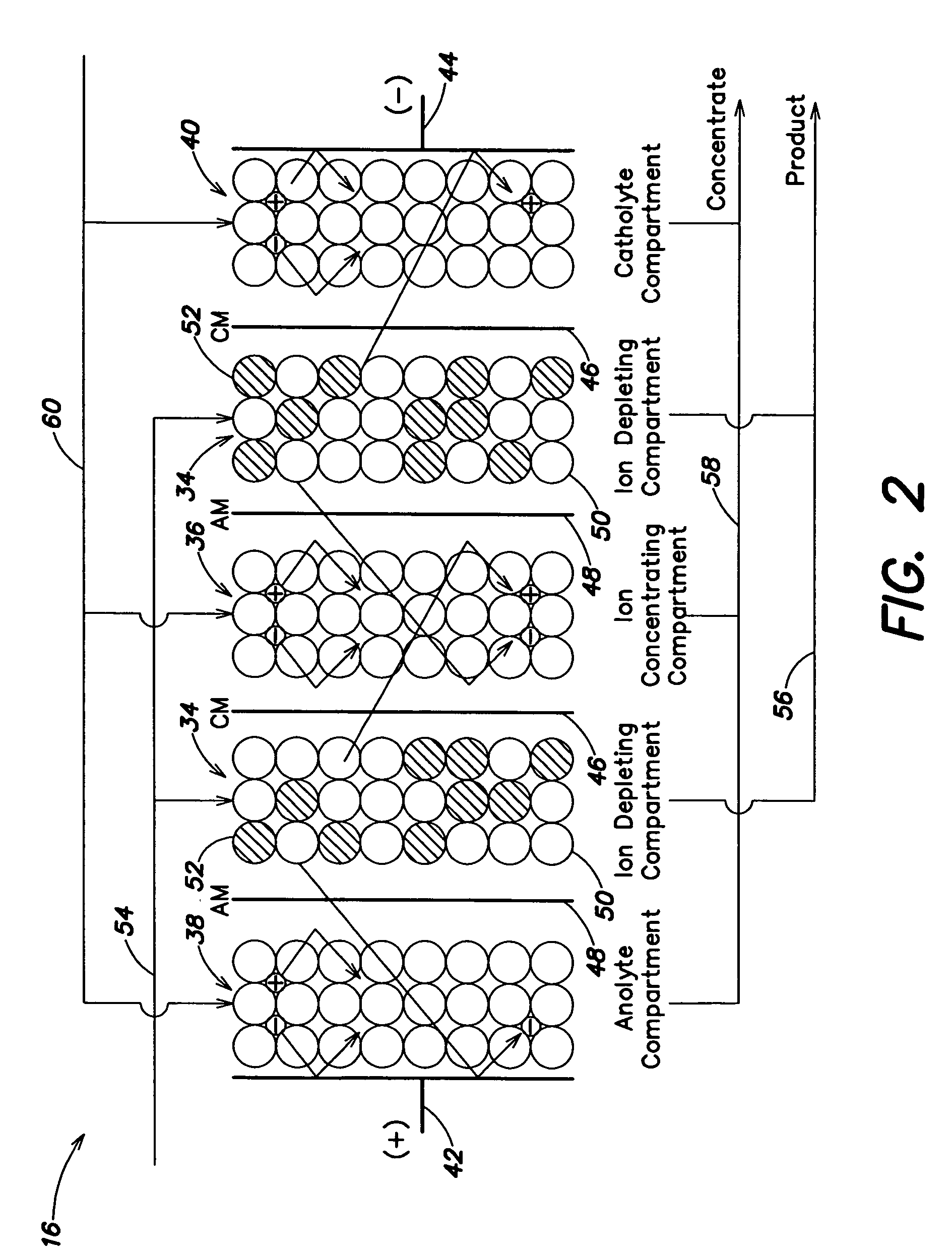Water treatment system and method
- Summary
- Abstract
- Description
- Claims
- Application Information
AI Technical Summary
Benefits of technology
Problems solved by technology
Method used
Image
Examples
example 1
[0068] A treatment system, schematically shown in FIG. 3, was designed and evaluated for performance. The treatment system 10 had an electrodeionization device 16 with a pretreatment system (not shown) and a pressurized vessel 12. Water, from point-of-entry 14, was introduced into pressurized vessel 12 and was re-circulated through electrodeionization device 16. The water treatment system was controlled by a programmable controller (not shown) based on the measured water conductivity, as measured by sensors 20b and 20c, upstream of an inlet 62 and downstream of an outlet 64 of pressurized vessel 12.
[0069] Electrodeionization device 16 comprised a 10-cell pair stack with 13-inch flowpaths. Each cell was filled with AMBERLITE® SF 120 resin and AMBERLITE® IRA 458 resin, both available from Rohm & Haas Company, Philadelphia, Pa. The electrodeionization device utilized an expanded titanium electrode coated with ruthenium oxide.
[0070] Pressurized vessel 12 was a 10-inch diameter fibergl...
example 2
[0074] An in-line water treatment system, schematically shown in FIG. 4, was designed, operated and evaluated for performance. The water treatment system 10 had an electrodeionization device 16 and a pressurized storage vessel 12. Water, from point-of-entry 14, was introduced into pressurized storage vessel 12 through inlet 62 and was circulated using pumps 30a and 30b and treated through pretreatment units 28a and 28b and electrodeionization device 16. The water treatment system was controlled by a programmable controller (not shown) based on the measured water conductivity, as measured by sensors any of 20a, 20b and 20c.
[0075] Electrodeionization device 16 was comprised of a 10-cell pair stack with flowpaths that were about 7.5-inches long and about 2.5-inches wide. Each cell was filled with about 40% AMBERLITE® SF 120 resin and about 60% AMBERLITE® IRA 458 resin, both available from Rohm & Haas Company, Philadelphia, Pa. The electrodeionization device had an expanded titanium el...
example 3
[0082] An in-line water treatment system, schematically shown in FIG. 5, was design operated and evaluated for performance. The water treatment system 10 had an electrodeionization device 16 and a vessel 12. Water from point-of-entry 14 was introduced into pressure vessel 12 through inlet 62. Water to be treated was withdrawn from pressurized storage vessel 12 and introduced into electrodeionization device 16 through either of valves 32a or 32b. The water treatment system also had pretreatment systems 28a and 28b upstream of electrodeionization device 16. Streams exiting electrodeionization device 16 was transferred through pumps 30a and 30b into either of pressurized storage vessel 12 or circulated back into electrodeionization device 16, depending on the service of valves 32c and 32d. Discharge to drain 26 of a concentrate stream was controlled by actuating valve 32e. Treated water was withdrawn from pressurized storage vessel 12 through outlet 64 and introduced as the product poi...
PUM
| Property | Measurement | Unit |
|---|---|---|
| Pressure | aaaaa | aaaaa |
| Power | aaaaa | aaaaa |
| Flow rate | aaaaa | aaaaa |
Abstract
Description
Claims
Application Information
 Login to View More
Login to View More - R&D
- Intellectual Property
- Life Sciences
- Materials
- Tech Scout
- Unparalleled Data Quality
- Higher Quality Content
- 60% Fewer Hallucinations
Browse by: Latest US Patents, China's latest patents, Technical Efficacy Thesaurus, Application Domain, Technology Topic, Popular Technical Reports.
© 2025 PatSnap. All rights reserved.Legal|Privacy policy|Modern Slavery Act Transparency Statement|Sitemap|About US| Contact US: help@patsnap.com



